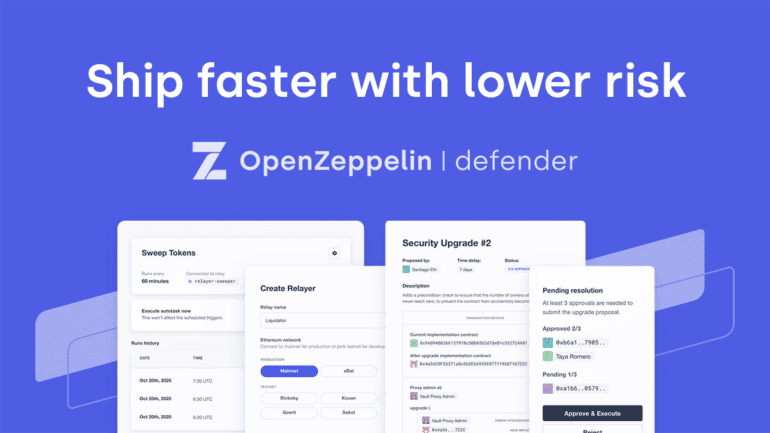TL;DR:
- OpenZeppelin unveils Defender 2.0, a comprehensive security platform for blockchain applications.
- Defender 2.0 integrates web2 security practices into web3, aiding the entire development lifecycle.
- Four key modules: Code Analysis, Audit Communication, Secure Deployment, Real-time Monitoring.
- Aimed at 23,000 monthly active blockchain developers, fostering secure coding, auditing, deploying, and monitoring.
- Crypto market experienced $390 million losses in July due to exploits, highlighting the need for enhanced security.
- Defender 2.0’s AI-driven analysis could have significantly reduced losses, according to OpenZeppelin.
- Launching in beta, emphasizing responsible development, with select customers and projects onboarded.
Main AI News:
In a remarkable leap towards fortifying the integrity of blockchain applications, OpenZeppelin, a distinguished name in crypto security, has introduced the much-anticipated Defender 2.0. This cutting-edge iteration is meticulously crafted to cater to the comprehensive development lifecycle of blockchain applications, effectively amalgamating the best practices of web2 security into the realm of web3.
The impact of this upgraded security behemoth is profound, potentially offering its prowess to approximately 23,000 active blockchain developers on a monthly basis, as affirmed by the firm itself. This comprehensive solution seamlessly integrates crucial stages such as coding, auditing, deploying, and monitoring into a cohesive continuum, nurturing the evolution of decentralized applications.
At the core of Defender 2.0 are four distinctive components, each tailored to synergistically contribute to its overarching mission. The Code Module, fueled by the marvels of machine learning, facilitates automatic code analysis. Its sophisticated algorithms meticulously scrutinize codebases, identifying vulnerabilities and illuminating pathways to enhancement. This revolutionary approach serves as a sentinel, safeguarding against potential threats through continuous vigilance.
The Audit Module, another cornerstone of Defender 2.0, forms a bridge of effective communication between developers and auditors. It prioritizes the elimination of critical bugs, engendering an environment where actionable recommendations become the bedrock of refinement. This collaborative approach not only elevates security but also accelerates the development process.
For the crucial phase of deployment, the Deploy Module steps in with its arsenal of security measures. This module enforces secure smart contract deployment and upgrades, mitigating the risk associated with vulnerabilities creeping in during these pivotal moments. The result is a fortified foundation for the subsequent stages of a blockchain application’s life cycle.
Rounding off this symphony of security is the Monitor, Respond, and Operate Module. With its real-time threat detection capabilities, this module offers an unyielding shield against potential hazards. Moreover, it provides invaluable insights into smart contract behaviors and risks, enabling proactive decision-making in the face of emerging challenges.
Founder of OpenZeppelin, Demian Brener, succinctly captures the aspiration of Defender 2.0—enhancing smart contract security throughout every facet of their existence, from embryonic development to full-fledged deployment and active production. This commitment to holistic security marks a pivotal moment in the evolution of blockchain technology.
Diverse in its capabilities, Defender 2.0 extends its protective umbrella over a range of blockchains, underscoring its versatility and relevance. Ethereum, Polygon, Arbitrum, Optimism, Base, and zkSync stand to benefit from its multifaceted security approach, heralding a new era of resilience within the crypto landscape.
The chronological tapestry of 2023 reveals a sobering reality—the crypto market experienced a staggering setback in July. A mind-boggling sum of $390 million was surreptitiously siphoned due to exploits, painting a vivid portrait of the perils that linger within the domain. The fiasco involving Multichain’s cross-chain bridge bore witness to the loss of $231 million, amplifying the urgency for stringent security protocols. These incidents, cumulatively accounting for $3 billion in DeFi-related thefts, emphasize the imperative nature of unyielding security measures.
OpenZeppelin emphatically states that the harrowing losses witnessed could have been appreciably mitigated with the robust shield of the right security infrastructure. Enter Defender 2.0—a sentinel with the potential to disrupt the trajectory of exploits and inject a renewed sense of confidence into the crypto realm.
While the operational status of Defender 2.0 is established, its launch is shrouded in the aura of a beta phase. This strategic approach accentuates the company’s commitment to responsible development practices. As an embodiment of OpenZeppelin’s dedication to perfection, select patrons and community-driven projects are being ushered in as torchbearers of this transformative security paradigm.
Conclusion:
In a dynamic crypto landscape, OpenZeppelin’s launch of Defender 2.0 marks a pivotal advancement in blockchain security. By introducing AI-driven analysis and real-time monitoring, the platform addresses the pressing need for comprehensive protection throughout the development lifecycle. The crypto market’s recent losses underscore the urgency for such solutions. As the market evolves, Defender 2.0 sets a precedent for responsible development and robust security measures, ushering in a safer era for blockchain applications and their stakeholders.

